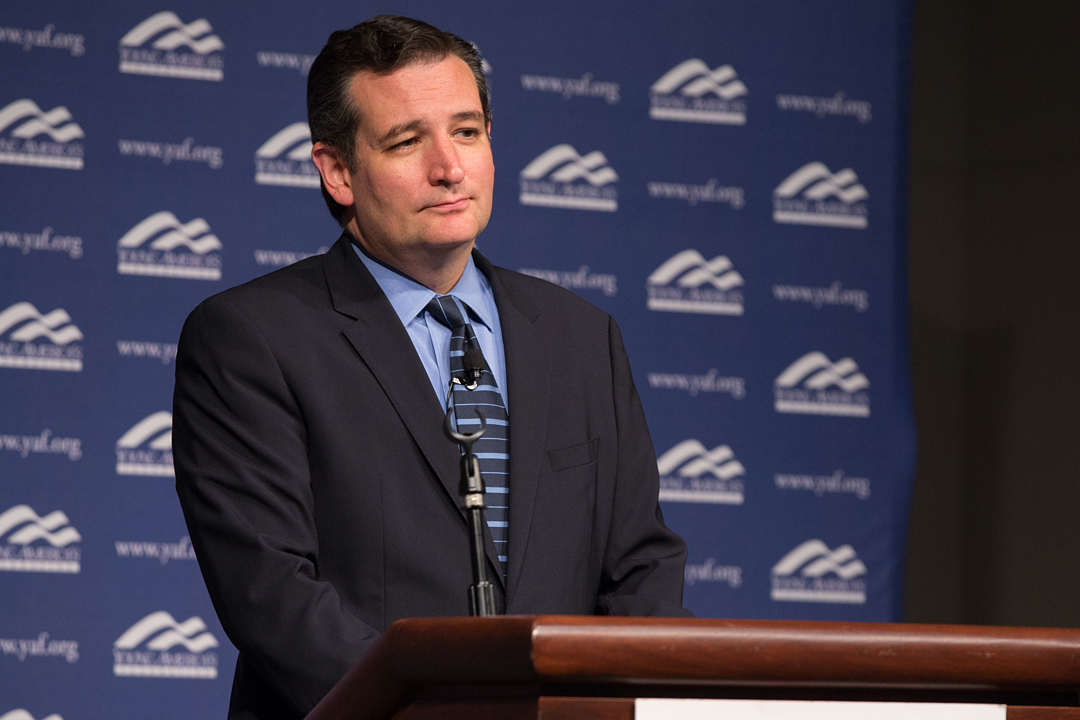(This story originally ran Jan. 27)
Editor's Note: On Monday, Republican voters turned out in record numbers at the Iowa caucuses. It was a big night for Ted Cruz, who won the state on the strength of his ground game, and Marco Rubio, who finished a strong third with 23 percent of the vote. Donald Trump? He came down to earth, capturing 24 percent of the vote and underperforming his poll numbers.
By James Irwin
At some point in the near future, the Republican presidential field will whittle to just above the size of a manageable carpool ride.
Until then, though there are some candidates in better shape (hello, Ted Cruz) than others (goodbye, Mike Huckabee), the way in which the field of 12 candidates reduces is unclear.
But that thinning could happen quickly, said Lara Brown, political management program director and associate professor at the Graduate School of Political Management.
By Valentine’s Day, she said, the race could be cut in half.
“It is going to narrow after New Hampshire,” she said. “By the time South Carolina and Nevada are over, I’d imagine we’ll be down to five candidates, at the maximum.”
Who will remain after the first primaries? The answer to that question will have a lot to do with the ability to mobilize voters and raise money, media strategy and the complex math the Republican Party uses to award its 2,472 delegates.
Discovery time for Trump, Cruz
The length of time a candidate remains viable often comes down to money. Funds usually dry up when voter support diminishes.
“While donors might be strong supporters of a candidate, they’re usually unwilling to throw money at a candidate who has no chance of winning,” said Danny Hayes, associate professor of political science at the Columbian College of Arts and Sciences.
That is bad news for Mr. Huckabee, Ben Carson—who has cratered in the polls—and Carly Fiorina, among others. It is good news for Sen. Cruz and frontrunner Donald Trump, who are in commanding positions at the moment.
But the Iowa caucuses and New Hampshire primary will be telling for the two leading candidates.
“I think we’re going to see in Iowa the strength of Trump’s support and the reach of the Cruz campaign,” Dr. Brown said. “For Trump, whether his voters decide to turn out or not is a question mark.”
Many of Mr. Trump’s supporters, she said, are nontraditional voters, including self-identified Republicans who are registered as Democrats, according to data provided to The Upshot by Civis Analytics. The problem with nontraditional voters? They don’t vote, especially in primaries. And the problem with self-identified Republicans who are registered Democrats? They might not be eligible to vote. Only 15 states hold open primaries, the rest require voters to be affiliated with the party.
It boils down to whether Mr. Trump has built an adequate grassroots campaign to identify prospective voters, register them as Republicans and physically get them to the voting booth, Dr. Brown said.
Dr. Hayes said Mr. Trump’s support has surprised him. “But it’s not clear whether the people in the polls are going to come out and support him,” he said. “A lot depends on what happens on Election Day and the mechanics of turning out voters. That’s harder to do than give a speech or get a lot of news coverage.”
 Ted Cruz has surged in the polls in recent weeks, and has put himself in position to possibly win in Iowa. The next few weeks will demonstrate the reach of his campaign, Dr. Brown said. (File photo)
Ted Cruz has surged in the polls in recent weeks, and has put himself in position to possibly win in Iowa. The next few weeks will demonstrate the reach of his campaign, Dr. Brown said. (File photo)
The complex calculus
It takes 1,237 delegates to secure the nomination. The number of delegates per state varies. In some states, like Florida and Ohio, the winner of the state primary receives all the delegates. In others—notably most of the states earlier on the primary calendar—delegates are split proportionally by the vote in the state (candidates are usually required to hit a certain threshold of support). And in some states, like South Carolina, some delegates are attached to congressional districts, meaning the winner of the district wins those delegates, with the rest divvied up proportionally or winner-take-all.
That is the CliffsNotes version. For a deeper look, Dr. Hayes suggests Frontloading HQ, an election and campaign blog run by University of Georgia lecturer Josh Putnum.
“The point is: It gets complicated,” Dr. Brown said. “Let’s imagine Ted Cruz wins Alabama. He gets the 10 delegates allocated in a statewide fashion. Then let’s say he also wins four congressional districts. Now he’s up to 22 delegates. Say Trump wins one congressional district. He gets three delegates. Then, say Rubio wins one district. He gets three delegates. Alabama is proportional as well, so you could divvy things up even further.”
It is almost like trying to run a House-style campaign—focused on a congressional district—and a Senate-style campaign—focused on the whole state—at the same time.
“But it’s worse because you have to travel all over the country and you need a huge network, and they are taking place at different times,” Dr. Hayes said.
The sequencing of the states is important, he added. Delegate-rich Texas awards proportionally, so it is a great state to boost support. But the Texas primary is March 1. By then, it might be too late.
“That’s why Iowa and New Hampshire are so important,” Dr. Hayes said. “They can raise the level of some candidates, encourage voters to see candidates as viable. It keeps them in the race.”
What to watch
Post-primary media spin plays a large role in the shape of the field. There are a lot of ways to win delegates, so there are many ways to call yourself a winner, Dr. Brown said.
“We’re going to see a great many campaign claims of success, justified on different things—size of the vote margin, number of delegates, number of districts,” she said. “And all of these things will be true, but the question is: What will the media believe, and what will the public believe?”
Political perception is important because it keeps the money flowing and it builds a narrative about a candidate, Dr. Hayes said.
“That allows them to go to their donors and say, ‘Get behind me, I’ve got the momentum,’” he said. “The famous story with Bill Clinton in 1992 was everyone thought his campaign was dead. He finished second in New Hampshire and was able to convert that second-place finish into a story about how he became ‘the comeback kid.’”
 Can Marco Rubio emerge as the "establishment" candidate? (File photo)
Can Marco Rubio emerge as the "establishment" candidate? (File photo)
The ‘establishment’ candidate
Sen. Cruz and Mr. Trump currently enjoy comfortable margins in Iowa and New Hampshire. That is partially because no one has emerged from the pool of “establishment” candidates. That could change soon, Dr. Brown said.
“We’re going to start to see who the establishment will coalesce around in Iowa and who will have a head of steam that will take them into New Hampshire,” she said.
That person could be Marco Rubio, Jeb Bush, John Kasich or Chris Christie. Sen. Rubio is polling in third place in both Iowa and New Hampshire, according to FiveThirtyEight, though he faces an uphill battle to win either state. Mr. Kasich has been focusing almost solely on New Hampshire and his poll numbers there just reached double-digits. The Super PAC backing Mr. Bush has been launching attack ads at Mr. Rubio and Mr. Kasich in recent weeks.
“They’re fighting each other,” Dr. Hayes said.
Mr. Christie, the most moderate candidate according to a FiveThirtyEight analysis of fundraising, voting records and public statements on issues, received an endorsement from the Manchester Union-Leader in November. He is in an advantageous position because of his background as a federal prosecutor, Dr. Brown said, given the race has focused heavily on national security.
“But at the same time his overall profile is much more moderate than the rest of the party,” she said. “And this is where he’s going to have some difficulties in the southern primaries.”
And his poll numbers have been flat, Dr. Hayes said. He sees a clearer path for Sen. Rubio.
“I think one plausible scenario is if Rubio places third or fourth in Iowa and second in New Hampshire to either Cruz or Trump, then it’s possible the Republican establishment starts to coalesce around him,” he said.





